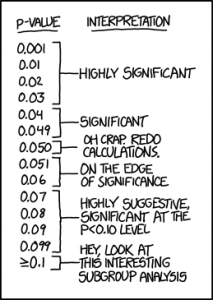Last week, the Norwegian socialist party (SV) added to their program that they wanted an age limit on male circumcision, at 15 years old. The socialist party is pretty small and the major parties do not agree, so there will be no change in Norwegian legislations on this. But there is one thing that have been bothering me – and does not really depend on one’s view on circumcision – which is the evidence on risk and benefits of circumcision.
A couple of years ago, male circumcision was much debated in Norway, and I considered writing something on this then. Never got around to it, though. I suppose similar discussions appear elsewhere from time to time, so this might be of some general interest. In the debates I’ve seen, those defending the practice frequently state that circumcision did no or little harm and actually have health benefits. The main scientific source referred to (at least in the debate in Norway) was the review of research published in Pediatrics in 2012. It was an official policy statement issued by the American Association of Pediatrics (AAP) and there was also a technical report which reviewed current evidence. As far as I am aware, this is still the AAP’s official stand on this matter. Importantly, the AAP do not generally recommend circumcision and it is not a considered a medical necessity. The main conclusion of the report is that the benefits outweight the risks. My concern here is what this means. The report discussed many potential risks and benefits of which some seems rather trivial to me, while others seems important. So how did the authors weight the risks and benefits against each other? I have no idea, because that is not described neither in the technical report or policy recommendation.
The report lists all evidence for and against a range of outcomes (most evidence is “fair”, and I think no evidence is “excellent”), but there are no judgments of how important each outcome is compared to the others. Clearly, it is hard to compare risks for very different diseases and complications, and I have no idea how this should be done. Both risks and benefits can be either trivial or important or anything in between. How do you weight a trivial harm with high probability against a serious benefit with extremely low probability? How do you weight a catastrophic complication of the procedure with extremely low probability against a certain but trivial benefit? How do you weight heterogeneous effects? These are very important considerations, and the panel have apparently made such considerations since they say these outcomes are weighted against each other. Still, the only argument is a long list of evidence on various outcomes. The considerations of trade-offs are highly informal, and I have no idea how they weight the unknowns.
I suggest that when writing a review and giving policy recommendations (on any topic) where you say something like “benefits outweight the risks“, at least you really need to get the following straight:
- If you say you have weighted benefits against risk, this better be clear and explicit. Just saying so is just not good enough. Not all risks and benefits are equally important and should be given different weights accordingly. Some risks should perhaps be avoided at all costs, some are quite manageable, and other risks are of no concern. Same applies to benefits: some are important, others are not. This needs to be made clear. Even if done badly would be better than nothing as it would allow important trade-offs to be discussed by others. If not explicit, I doubt it has been done at all.
- Moreover, some benefits can be achieved by other means without risk. With no such considerations, the weighting of pros and cons have not really been done.
- Risks which are possible but no estimates exist needs to be explicitly considered anyway. For example, if you do (as AAP does) state things like e.g. “there are no adequate studies of late complications”. You need to make it clear how lack of knowledge are given weight.
My main point is just that the AAP lacks a clear argument for their policy recommendation. It seems pretty opaque.
The post Risk-benefit considerations of male circumcision appeared on The Grumpy Criminologist 2018-04-23 10:00:26 by Torbjørn.

